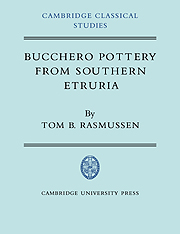Summary
AMPHORA
Recent studies have helped to make the development of the amphora clearer: Dohrn and Colonna have examined the impasto types; Verzár has tackled the evolution of the later bucchero amphorae.
The amphora of Type 1 is characterized by the conical neck and the ribbon handles from shoulder to rim. There is a clear line of development from the earliest types to the ‘Nikosthenic’ shape, and the latter is in no way derived from the Villanovan biconical urn as once suggested (by Gallatin, AJA 30 (1926), 76ff.).
Types 1a and 1b are often decorated with a double spiral on the body, which has given rise to the term ‘spiral amphora’. These types (especially in impasto) are also sometimes called ‘anfora laziale’, although they are as common on S. Etruscan and Faliscan sites as in Latium.
The typology of the impasto amphora is summarized by Colonna (MEFR 82 (1970), 637ff.). His view is that the shape begins very squat (Type A), the body narrowing to globular during the first half of the seventh century (Type B). The latter type occurs not uncommonly, the narrower and later Type? almost exclusively in bucchero. This agrees well with the later development of the shape in bucchero, where the most noticeable trend is the progressive narrowing and heightening of the body. This in itself would tend to discredit Dohrn's conclusion (Dohrn 1965, 149) that the impasto amphora develops from narrow to broad. Dohrn would place the very broad examples from the Vaccareccia tombs at Veii (Palm, 61ff.: Tomb 1 no.2, Tomb 4 no.8, Tomb 5 no.3 etc.) typologically late in his series.
- Type
- Chapter
- Information
- Bucchero Pottery from Southern Etruria , pp. 68 - 127Publisher: Cambridge University PressPrint publication year: 1979

